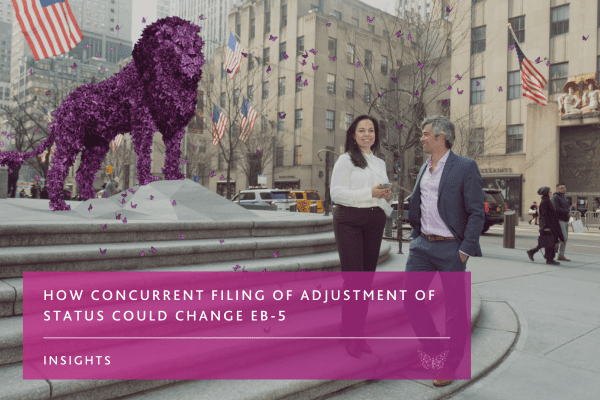One of the RIA’s provisions could make EB-5 more attractive to investors already living in the U.S.
When the EB-5 Reform and Integrity Act of 2022 (RIA) was passed, it brought a wealth of changes to the EB-5 Immigrant Investor Program. Among the many new rules and updates was a provision that allowed for concurrent filing of Adjustment of Status with I-526 applications. The benefits of this change may not be obvious, but can greatly affect how certain visa holders approach EB-5. Let’s take a look at how concurrent filing works and how it may change who is looking to pursue EB-5.
How the RIA changed filing for Adjustment of Status
Prior to the RIA, an investor’s Form I-485 Application for Adjustment of Status could not be filed until after their I-526 petition had been approved. Investors already residing in the U.S. on non-immigrant visas who were pursuing EB-5 may have been unable to work while awaiting adjudication, and they and their relatives may have been subject to travel restrictions or other limitations. Until I-526 adjudication, they were not even able to file the application to receive a work permit.
USCIS processing has been notoriously slow, and for applicants already residing in the U.S., this lengthy wait could prove too burdensome, especially if they were in the country on an employment-based visa with a ticking clock that would kick in should they find themselves unemployed.
Thanks to the RIA, immigrant investors can file Form I-485 before their Form I-526 is approved, so long as a visa is “available” at the time. As explained in an article from IIUSA, “For new investors, this means a Form I-485 can be filed concurrently (at the same time) as the Form I-526. For existing investors, this means a Form I-485 can be filed before the pending Form I-526 is approved.”
Filing for Adjustment of Status includes Form I-765, the application for work authorization, and Form I-131, which allows applicants to travel. With these benefits, concurrent filing can give investors the freedom to pursue their goals in the U.S. as they await adjudication.
How concurrent filing works
Before embarking on this process, applicants must determine if they are eligible. Concurrent filing involves Form I-485, which adjusts the status of the visa holder from a nonimmigrant visa to that of a permanent resident awaiting EB-5 adjudication. USCIS states concurrent filing is allowed for certain groups, including “Most employment-based applicants and their eligible family members when a visa number is immediately available.”
If an individual is eligible, they can take the first step, which is an EB-5 investment. Under the RIA, the minimum investment amount is $800,000 for projects in a Targeted Employment Area (TEA) and $1,050,000 for non-TEA projects. This amount must be “at risk” for the required time period and create at least 10 jobs. There are many requirements for EB-5 investments that immigrant investors should familiarize themselves with, and proper due diligence of the project is always important before making an investment.
After the investment has been made, the investor must file Form I-526, Immigrant Petition by Standalone Investor, or Form I-526E, Immigrant Petition by Regional Center Investor. As of January 2024, an I-526E requires a filing fee of $3,675 plus an additional $1,000 per the RIA. In addition to the applicant’s personal information and history, the form requires information about the Regional Center, NCE, and specifics of the investment. Petitioners can’t file this form without the necessary information from their Regional Centers, which is why investors seek out issuers that offer on-demand information through a secure online portal.
At the same time, the investor can file Form I-485, Application to Register Permanent Residence or Adjust Status. This form involves questions about current immigration status along with detailed personal information (be prepared to answer whether you intend to practice polygamy and list every organization to which you have ever belonged).
USCIS states the following regarding concurrent filing:
To be considered concurrently filed, the immigrant visa petition and the adjustment of status application (Form I-485) are filed at the same time and mailed together with all the required filing fees and supporting documentation to the same filing location. They will also be considered concurrently filed if the adjustment of status application (Form I-485) is filed after the immigrant visa petition but while the immigrant visa petition remains pending.
The filing fee will vary based on the applicant’s age, but for applicants aged 14-78, this fee is $1,225 as of January 2024. Note that while submitted simultaneously, the payments for the I-526 and I-485 filing fees must be separate. Submitting a single combined payment can result in rejected applications.
Applicants will receive a response to their I-526 and I-485 applications separately. The success of the I-485 application depends on the success of the I-526 application. However, just because the I-526 is approved, that doesn’t mean I-485 approval is guaranteed.
Along with Form I-485, applicants can submit Form I-131, Application for Travel Document, and Form I-765, Application for Employment Authorization. To speed up the process, USCIS often decouples these applications and adjudicates Form I-765 first. Average time to receive an Employment Authorization Document (EAD) is estimated at around six months, but could be longer or shorter depending on the specifics of the application.
Benefits of concurrent filing
One of the chief benefits of concurrent filing is the ability to obtain an EAD card, which allows applicants to work for any employer without visa sponsorship, or even start their own businesses. This could be attractive to freelancers, those who work in multiple fields, or applicants previously on student visas who want to be able to take advantage of opportunities without being dependent on H-1B visa lotteries, where only around 10% of applications are successful.
“The EB-5 visa provides a tremendous opportunity for H-1B holders to gain flexibility in their career options and long-term stability in their immigration status as they would no longer need sponsorship from an employer,” said Peter Calabrese, CEO of CanAm Investor Services.
Traditionally, H-1B holders who are laid off have only 60 days to find new employment or adjust their status. That’s not much time to make an EB-5 investment. However, thanks to recent changes to the Immigrant Nationality Act, these visa holders have additional time. Section INA 245(k) allows for up to 180 days after the grace period for applicants to file for Adjustment of Status, provided they are eligible and physically present in the U.S.
In addition to greater freedom to work, concurrent filing allows for freedom of movement through Form I-131, which requests permission for applicants to travel both within and outside the country while applications are pending. Those engaging in international business or who want to visit relatives outside the country will appreciate this freedom as they await adjudication, just one more reason why EB-5 investment paired with concurrent filing may look extremely attractive to H-1B holders post-RIA.
Why concurrent filing could be a big deal in 2024
Concurrent filing for H-1B holders became a major topic of discussion in 2023 thanks to heavy layoffs in the technology sector, including at some of the largest U.S. tech companies. Though some of those jobs have returned, the replacement positions may largely be lower-paying jobs than those that were lost. Workers who’ve been in the country a long time and no longer wish to deal with the uncertainty of nonimmigrant status may see this as the right time to make their residency permanent through EB-5.
“Last year’s tech layoffs were a difficult reminder of the uncertainty that comes with holding an H-1B,” said Calabrese. “I believe we’ll see an influx of EB-5 filings this year, both from people who were laid off last year and from current H-1B holders in this sector who want to protect themselves and their families in case of future layoffs.”
Another factor is the RIA’s reserved visas for rural, high-unemployment, and infrastructure projects, which are being adjudicated much faster than traditional EB-5 applications. It’s possible those reserved categories could fill up, making now the ideal time for those who’ve been thinking about EB-5 to make an investment and take advantage of reserved visas while they’re available.
“We do not know precisely how long China and India will remain open for filing,” said Bernie Wolfsdorf, managing partner of WR immigration and former AILA president, “but based on the number of cases filed, the many approvals we are already getting, and historical data, it appears we maybe have one month left for Chart B filings [as listed in the visa bulletin], and a few months left for Chart A to file.
For investors from most countries, there is no rush to take advantage of reserved categories because their countries of origin are still “current.” But for H-1B holders from China and India, countries that with long EB-5 wait times, there is currently an incredible opportunity to start the EB-5 process and apply for Adjustment of Status while taking advantage of the priority processing for rural investments.
“The program is 34 years old, but never before have investors had such a wonderful opportunity to live the American Dream,” said Wolfsdorf.
Investors pursuing concurrent filing may have different priorities than traditional EB-5 investors. Since they’re already in the country, they may have a better understanding of the U.S. market, and as such might already have in mind the type of project in which they want to invest. They also might want to invest in projects that are closer to where they already live. Working professionals have different needs from high net-worth individuals (HNWI), and the investment amount and time frame may be major factors for them. As this is potentially a whole new class of EB-5 investor, Regional Centers that understand and target these investors’ specific needs will have a leg up.
As the most experienced EB-5 administrator, JTC offers a range of services to help Regional Centers offer more to immigrant investors. Our flexible banking and escrow solution provides greater security for investor funds, our 24/7 online portal allows them to view investment and project status at any time, and our RIA-compliant fund administration can provide peace of mind that the Regional Center is doing all it can to ensure success.
JTC also offers immigration workflow, wealth management, and other services for immigrant investors as they pursue their goals in the U.S. When investors see an issuer is working with JTC, they know their Regional Center is doing the utmost to provide them with the best experience possible, which is why JTC is seen as a seal of quality by EB-5 investors.
Learn more about how JTC is improving the EB-5 investor experience.
Stay Connected
Stay up to date with expert insights, latest updates and exclusive content.
Discover more
Stay informed with JTC’s latest news, reports, thought leadership, and industry insights.
Let’s Bring Your Vision to Life
From 2,300 employee owners to 14,000+ clients, our journey is marked by stability and success.



















